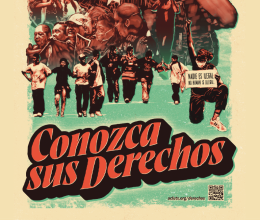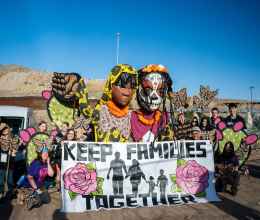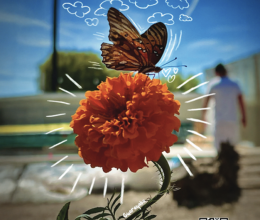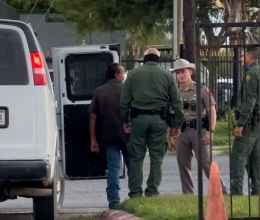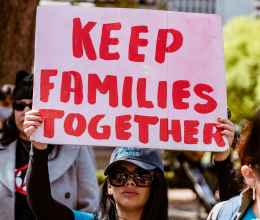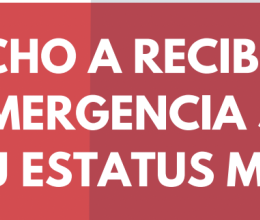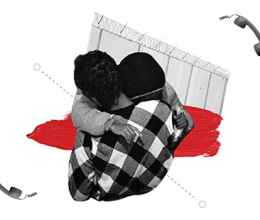
“Look, but do not stare,” I tell myself, as our group was walked into a circle of hell.
There were about forty of us, advocates in different ways for the immigrants who have made their way to our country. Several of the organizations had been working for years to make the Border Patrol transparent and responsible for its policing actions. The quarterly meetings with Border Patrol leadership had resulted in scant change. Since 2010, at least forty-six people have died as the result of an encounter with US border agents. The discussions between the immigrant advocates and the Border Patrol typically take place in Washington, DC, but, this time the meeting was being held in McAllen, Texas.
The McAllen Border Patrol processing center achieved infamy for the shameful way thousands of Central American children were treated in the summer of 2014. The nation’s largest police agency, even with its extraordinary budget, had been overwhelmed by the children and families that had surrendered to them. Children had been packed into cement cells in conditions that inspired concentration camp type metaphors. The center, commonly known by immigrants as la hielera (“the icebox”) for the practice of keeping the temperatures a chilling 68 degrees, had since been revamped. The advocates had been invited to see the improvements that the border patrol had introduced since the summer of 2014.
As we walked through the security doors into the processing center, I sidled up to one of the advocates visiting from Arizona. I said to her, “I know we are here to observe, but I hate looking at the detainees.” “Yes,” she said, “It is the most frequent complaint we get—the fact that there is no privacy, that they are stared at, as if they were animals in the zoo. And that they are treated as criminals.”
The immigrants are not criminals. For all of the rhetoric in public about “illegal aliens,” most of the men, women, and children crossing into Texas from the south are refugees desperately fleeing horror. Many, many of them could make legitimate asylum claims. But first, they have to get to the US (applying for asylum in a Central American country doesn’t work), and the Border Patrol’s processing center is the alternative port of entry for the poorest and most desperate, for those who cannot get a visa.
The stories are distressingly similar. A gentle Honduran whom I had met at a refugee center just the day before our visit to the processing center had told me his story. “My wife was raped and scalped. I knew that my children would be next; I knew this, so I put them into the hands of God and headed north. I have a brother who lives in (he struggled to pronounce Silver Spring, Maryland), if I can just get there. We survived Mexico, but oh, how we prayed, oh how we had people praying with us. And then we crossed the Rio Bravo, and surrendered to the Border Patrol who took us to the hielera.”
As the group filed through the processing center, I continued to do my best not to stare. But there were so many children in that place. Their faces were pressed up against the smudged windows of the cell doors, their eyes wide open. They were staring at us. We were the only ones in the room not wearing either the green uniform of the Border Patrol, or the worn out uniform of the immigrant. Perhaps, to them, we represented hope.
The children were packed into their cells, and then there were the other cells, jammed with younger mothers. The moms seemed worn out, and distressed, their babies whimpering.
Through the window of another cell, I could see a man, lying face up on the concrete bench in the cell. He was asleep. On his chest, lying face down, slept a baby. The man’s arm was draped over the baby, creating a small safe place for his child. They were both lying there, quite still, and in that place of racket and fear, I was reminded of the tenderness of the Pieta. Only in case the child is alive; her father, too, was alive.
They had survived the journey across Mexico. And now they were resting.
The holding cells open out into a center space. Computers and screens were set out around a horseshoe-shaped desk. After the 2014 public relations disaster, the border patrol now aims to get the newly arrested immigrants processed and on their way within forty-eight hours. To facilitate the procedure, they had set up a remote screening process, so that agents from around the country could help. At one screen, I noticed a mother sitting sideways on a bench, her baby, a toddler, leaning up against her thin legs. On the computer monitor she was using, I could see another woman, dressed as a border patrol agent, taking notes. The two women seem to be about the same age.
This mother was sharing the bench with another woman, who was having her own interview on a screen set right next to the other monitor. There was no privacy, and, while the helpful agent conducting the tour assured us that the immigrants were only sharing biographical information, we knew that these people had been trafficked by human smugglers. The coyotes will do all they can to protect their dirty business. The traffickers know where the refugees’ families live in Central America, and use that threat to control their human cargo. No one is going to say much in front of others, who may be spies or traffickers themselves. I was told by an attorney that this initial interview is critical to the asylum claim, but the lack of privacy here undermines that claim from the beginning.
The immigrants had not bathed and their clothing was filthy. The center was filled with the cloying stench of wet tennis shoes, and another, subtle but disturbing odor.
One of the visitors said, “You can smell the fear in here.”
During the days prior to this tour, I had been reading Nadeem Aslam’s The Blind Man’s Garden. Aslam has a passage about the importance of seeing, of staring:
Father Mede stands up and crosses the room that has a pattern of black and white griffins on the floor. He comes to stand before the small painting on the wall that Sofia had made for him. The crucified Christ, and the weeping figures at the foot of the cross. They are his mother and his friends and they are weeping because this — the crucifixion — is taking place, and it is powerful because the suffering of the tortured man and the suffering of those watching him are in the same picture. Are in the same glance. Injustice is not occurring in a distant hidden pocket, and the grief of the victim’s relatives is not in a far removed place, disconnected from the crime. He will die, and those who love him are watching him — and all of it being watched by the viewer.
And so, as we came to the end of our tour, I stopped, and I took one last, long look at this place. I stared, aware now that I was not looking but watching, that I had accepted the responsibility that comes with having seen an injustice taking place in my midst.
This injustice was not created by the border patrol agents, but by my people, our people. As a nation, we have become disabled by our common fear of the stranger. This terror has expanded to include children and the innocent. That we as a nation suffer from that fear terrorizes me.
And yet I can’t think of a single person in my personal life, not even amongst the most socially conservative of them, that would turn their backs on even one of these innocents. Not if they could see them, not if they could speak with them, and then, speaking with them, come to know them, and, then, in very short order, not fear them.
At that point, perhaps, my fellow Americans would begin to watch out for them.
This post originally appeared Views From Alongside a Border. It is republished her with permission.
Michael Seifert served as a Roman Catholic priest in the Rio Grande Valley for 24 years. In 2009 he retired from the priesthood and married. He now works as a Network Weaver for the Rio Grande Valley Equal Voice Network.
